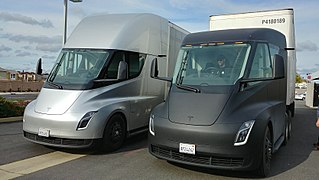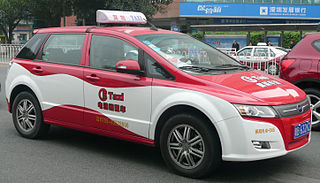
An electric vehicle (EV) is a vehicle that uses one or more electric motors or traction motors for propulsion. An electric vehicle may be powered through a collector system by electricity from off-vehicle sources, or may be self-contained with a battery, solar panels, fuel cells or an electric generator to convert fuel to electricity. EVs include, but are not limited to, road and rail vehicles, surface and underwater vessels, electric aircraft and electric spacecraft.

The General Motors EV1 was an electric car produced and leased by General Motors from 1996 to 1999. It was the first mass-produced and purpose-designed electric vehicle of the modern era from a major automaker and the first GM car designed to be an electric vehicle from the outset.

Electric vehicles first appeared in the mid-19th century. An electric vehicle held the vehicular land speed record until around 1900. The high cost, low top speed, and short-range of battery electric vehicles, compared to 20th century internal combustion engine vehicles, led to a worldwide decline in their use as private motor vehicles; although electric vehicles have continued to be used in the form of loading and freight equipment and public transport – especially rail vehicles.

BYD Auto Co., Ltd. is the automotive subsidiary of the Chinese multinational BYD Co Ltd, which is based in Xi'an, Shaanxi Province. It was founded in January 2003, following BYD Company's acquisition of Tsinchuan Automobile Company in 2002. The company produces automobiles, buses, electric bicycles, forklifts, rechargeable batteries and trucks. The current model range of automobiles includes electric vehicles, plug-in hybrids and petrol-engined vehicles.

A plug-in hybrid electric vehicle (PHEV) is a hybrid electric vehicle whose battery can be recharged by plugging a charging cable into an external electric power source, in addition to internally by its on-board internal combustion engine-powered generator. Most PHEVs are passenger cars, but there are also PHEV versions of commercial vehicles and vans, utility trucks, buses, trains, motorcycles, mopeds, and even military vehicles.

Plug In America (PIA) is a 501(c)(3) non-profit educational organization that promotes and advocates the use of plug-in cars, trucks and sports utility vehicles (SUVs) powered by domestic and renewable electricity which it claims will help reduce dependence on fossil fuels, improve the global environment and reduce greenhouse gases and climate change.

Who Killed the Electric Car? is a 2006 documentary film that explores the creation, limited commercialization, and subsequent destruction of the battery electric vehicle in the United States, specifically the General Motors EV1 of the mid-1990s. The film explores the roles of automobile manufacturers, the oil industry, the federal government of the United States, the California government, batteries, hydrogen vehicles, and consumers in limiting the development and adoption of this technology.

The automotive industry in China has been the largest in the world measured by automobile unit production since 2008. Since 2009, annual production of automobiles in China exceeds both that of the European Union and that of the United States and Japan combined.

Andrew Alfonso Frank is an emeritus American professor of Mechanical and Aeronautical Engineering at University of California, Davis. He is recognized as the father of modern plug-in hybrids, and coined the now-common term Plug-in Hybrid Electric Vehicle (PHEV). He has a B.S.M.E degree (1955) from the University of California, Berkeley, a M.S.M.E (1958), from the University of California, Berkeley, an M.S.E.E (1965) from the University of Southern California, and holds a Ph.D. in E.E (1968) from the University of Southern California. Frank worked at North American Aviation then North American/Rockwell Aviation from 1955 to 1968 on programs such as the X15 Research Aircraft, Helicopter stability and control systems, the Apollo Project to the moon, and the Minuteman intercontinental ballistic missile programs. He received patents and provided many innovations and solutions that allowed the programs to be more successful and effective. His patents continue to be in use today.

CalCars was a charitable, non-profit organization founded in 2002 to promote plug-in hybrid electric vehicles (PHEVs) as a key to addressing oil dependence and global warming both nationally and internationally. It was active until 2010, when the first mass-produced PHEVs arrived. CalCars envisioned millions of plug-in hybrid electric vehicles, charged by off-peak electricity from renewable energy sources, and with their internal combustion engines powered by low-carbon alternative fuels, as a way to significantly reduce greenhouse gases that come from transportation.

The history of plug-in hybrid electric vehicles (PHEVs) spans a little more than a century, but most of the significant commercial developments have taken place after 2002. The revival of interest in this automotive technology together with all-electric cars is due to advances in battery and power management technologies, and concerns about increasingly volatile oil prices and supply disruption, and also the need to reduce greenhouse gas emissions. Between 2003 and 2010 most PHEVs on the roads were conversions of production hybrid electric vehicles, and the most prominent PHEVs were aftermarket conversions of 2004 or later Toyota Prius, which have had plug-in charging and more lead-acid batteries added and their electric-only range extended.

An electric car is a car which is propelled by one or more electric motors, using energy stored in rechargeable batteries. Compared to internal combustion engine (ICE) vehicles, electric cars are quieter, have no exhaust emissions, and lower emissions overall. In the United States, as of 2020, the total cost of ownership of recent EVs is cheaper than that of equivalent ICE cars, due to lower fueling and maintenance costs. Charging an electric car can be done at a variety of charging stations; these charging stations can be installed in both houses and public areas.

A battery electric vehicle (BEV), pure electric vehicle, only-electric vehicle or all-electric vehicle is a type of electric vehicle (EV) that exclusively uses chemical energy stored in rechargeable battery packs, with no secondary source of propulsion. BEVs use electric motors and motor controllers instead of internal combustion engines (ICEs) for propulsion. They derive all power from battery packs and thus have no internal combustion engine, fuel cell, or fuel tank. BEVs include – but are not limited to – motorcycles, bicycles, scooters, skateboards, railcars, watercraft, forklifts, buses, trucks, and cars.
Felix Kramer is an entrepreneur, strategist and writer. After a succession of jobs and projects in the nonprofit sector and an early internet startup, he gained attention after 2002 as the founder of the California Cars Initiative, promoting mass production of plug-in hybrid electric vehicles. Since 2009, he has written broadly on climate change awareness and solutions, and collaborated on or co-founded climate-related projects.

The Cornell 100+ MPG Team was the first officially registered university team competing in the Progressive Insurance Automotive X Prize Competition. The group was made up of over 70 undergraduate and graduate students from six of Cornell University’s seven colleges including the College of Engineering, the College of Architecture, Art, and Planning, the College of Human Ecology, and the Johnson Graduate School of Management.

The patent encumbrance of large automotive NiMH batteries refers to allegations that corporate interests have used the patent system to prevent the commercialization of nickel metal hydride (NiMH) battery technology. Nickel metal hydride battery technology was considered important to the development of battery electric vehicles, plug-in hybrid electric vehicles (PHEVs) and hybrid electric vehicles (HEVs) before the technology for lithium-ion battery packs became a viable replacement.

A plug-in electric vehicle (PEV) is any road vehicle that can be recharged from an external source of electricity, such as wall sockets, and the electricity stored in the rechargeable battery packs drives or contributes to drive the wheels. PEV is a subset of electric vehicles that includes all-electric, or battery electric vehicles (BEVs), and plug-in hybrid vehicles (PHEVs). In China, plug-in electric vehicles are classified as new energy vehicles (NEVs). Sales of the first mass-production plug-in cars by major carmakers began in late December 2010, with the introduction of the all-electric Nissan Leaf and the plug-in hybrid Chevrolet Volt.

China is both the largest manufacturer and buyer of electric vehicles in the world, accounting for more than half of all electric cars made and sold in the world in 2018. China also makes 99% of the world's electric buses.

The stock of plug-in electric vehicles in California is the largest in the United States, with cumulative sales of almost 835,000 plug-in cars by the end of 2020. California is the largest U.S. car market with about 10% of all new car sales in the country, but has accounted for almost half of all plug-in cars sold in the American market since 2011. Since November 2016, China is the only country market that exceeds California in terms of cumulative plug-in electric car sales.

Karma Automotive is a producer of luxury electric vehicles founded in 2015. Headquartered in Irvine, California with an assembly plant located in Moreno Valley, California, Karma sells vehicles via its dealer network of locations in North America, Europe, South America, and the Middle East.


















